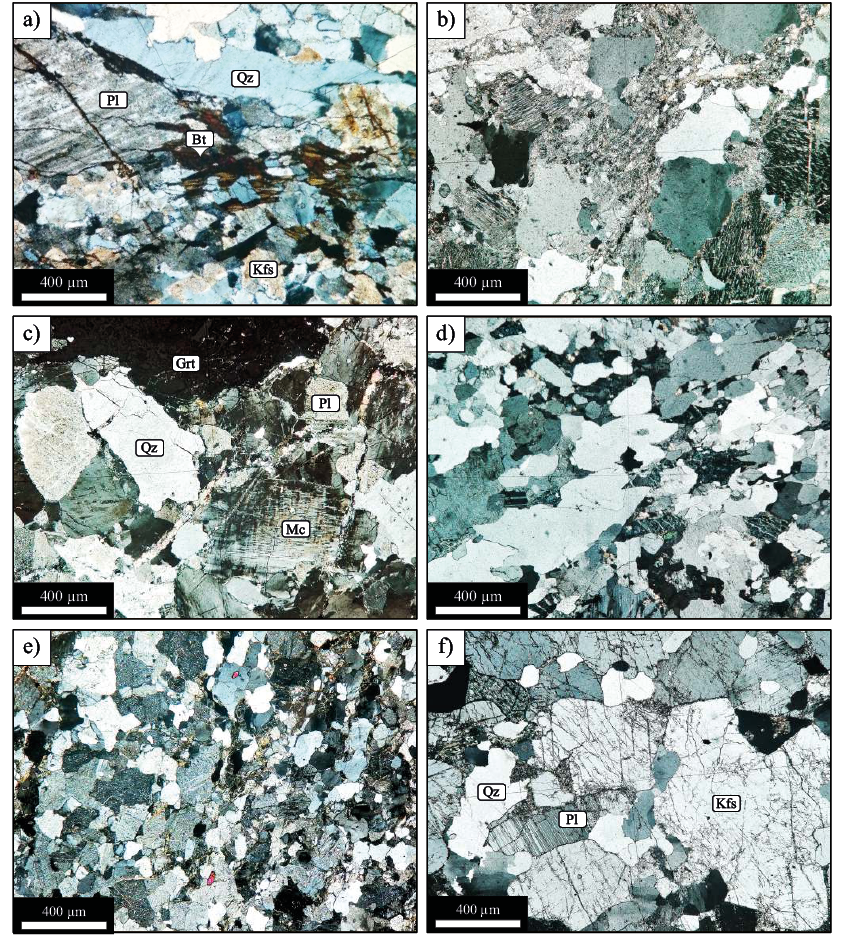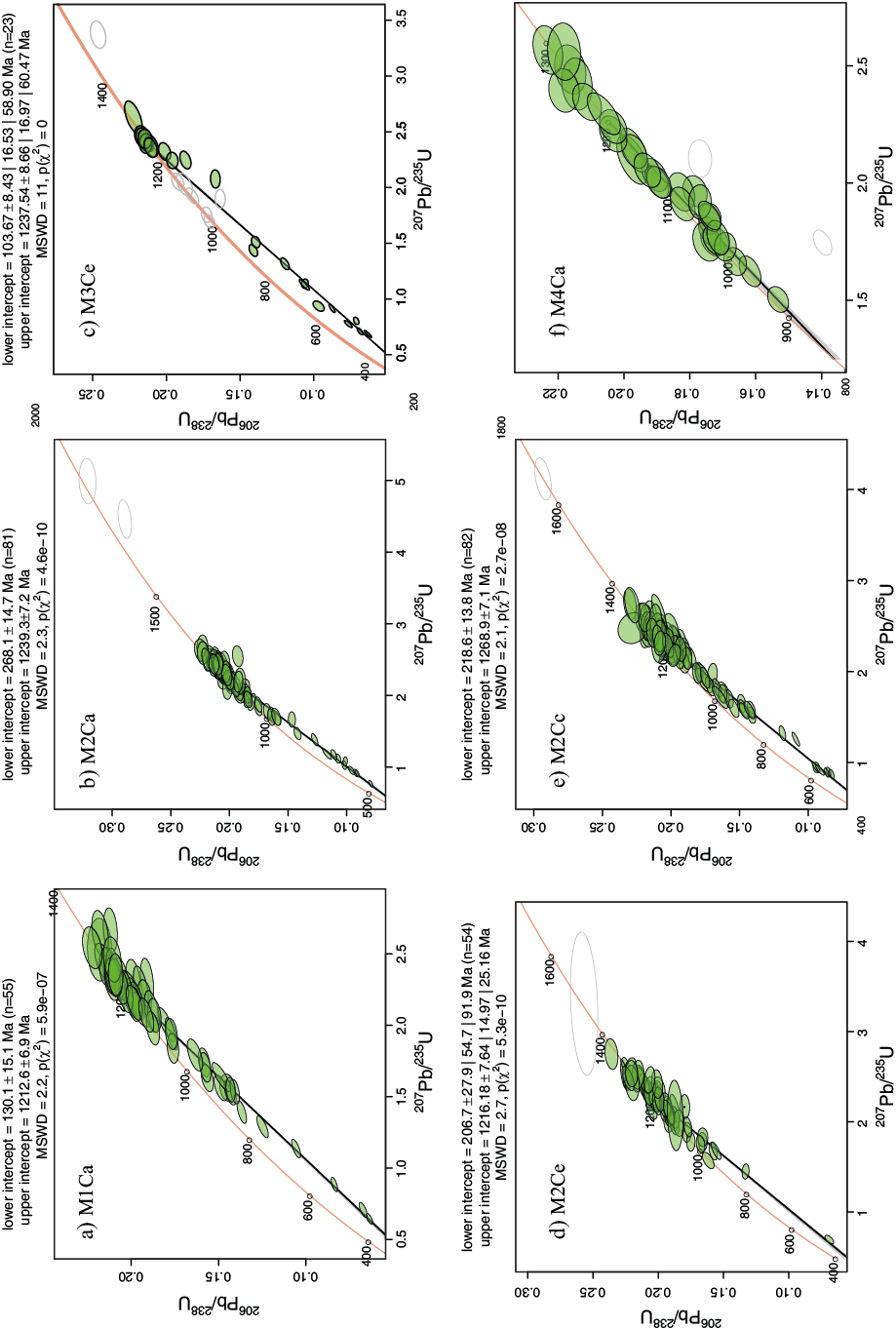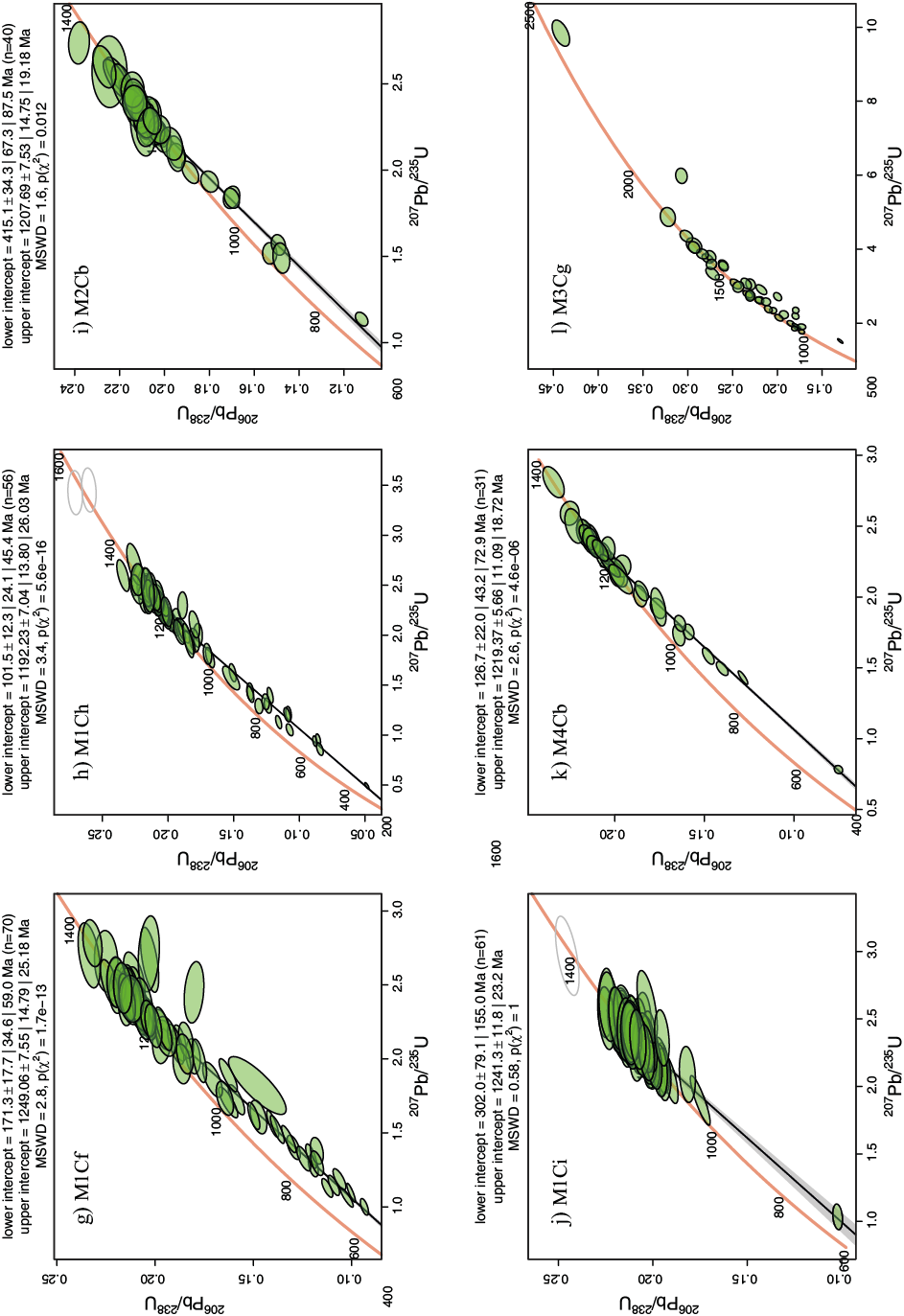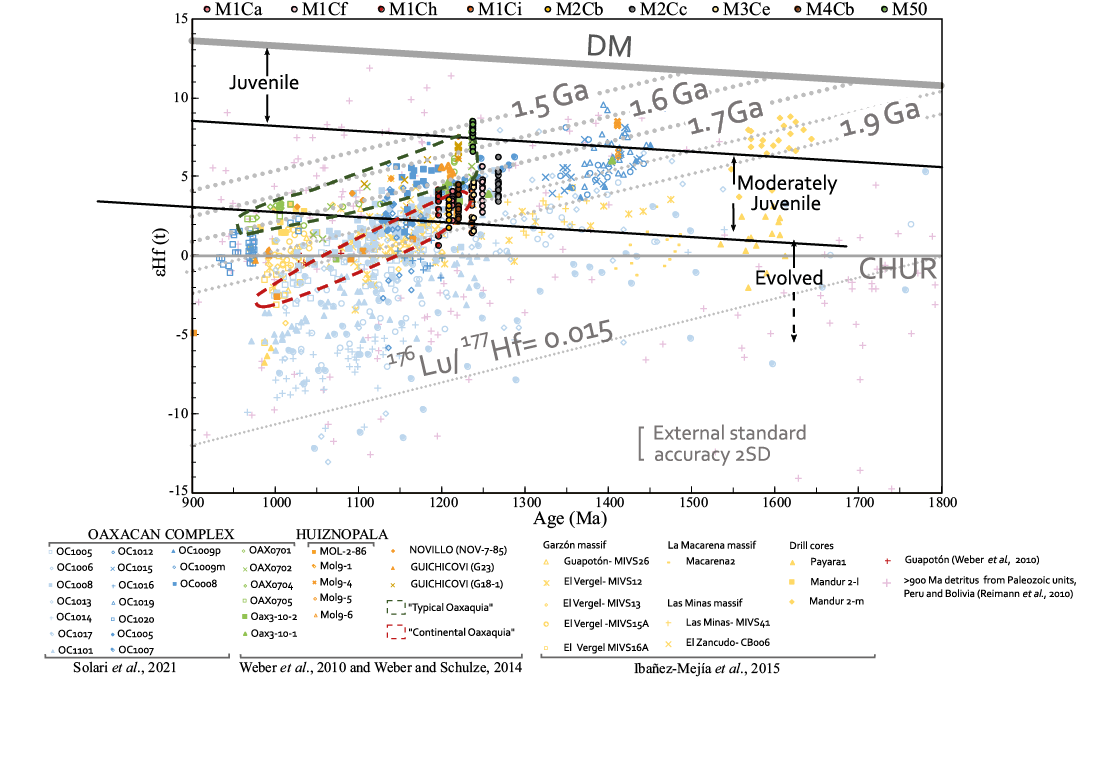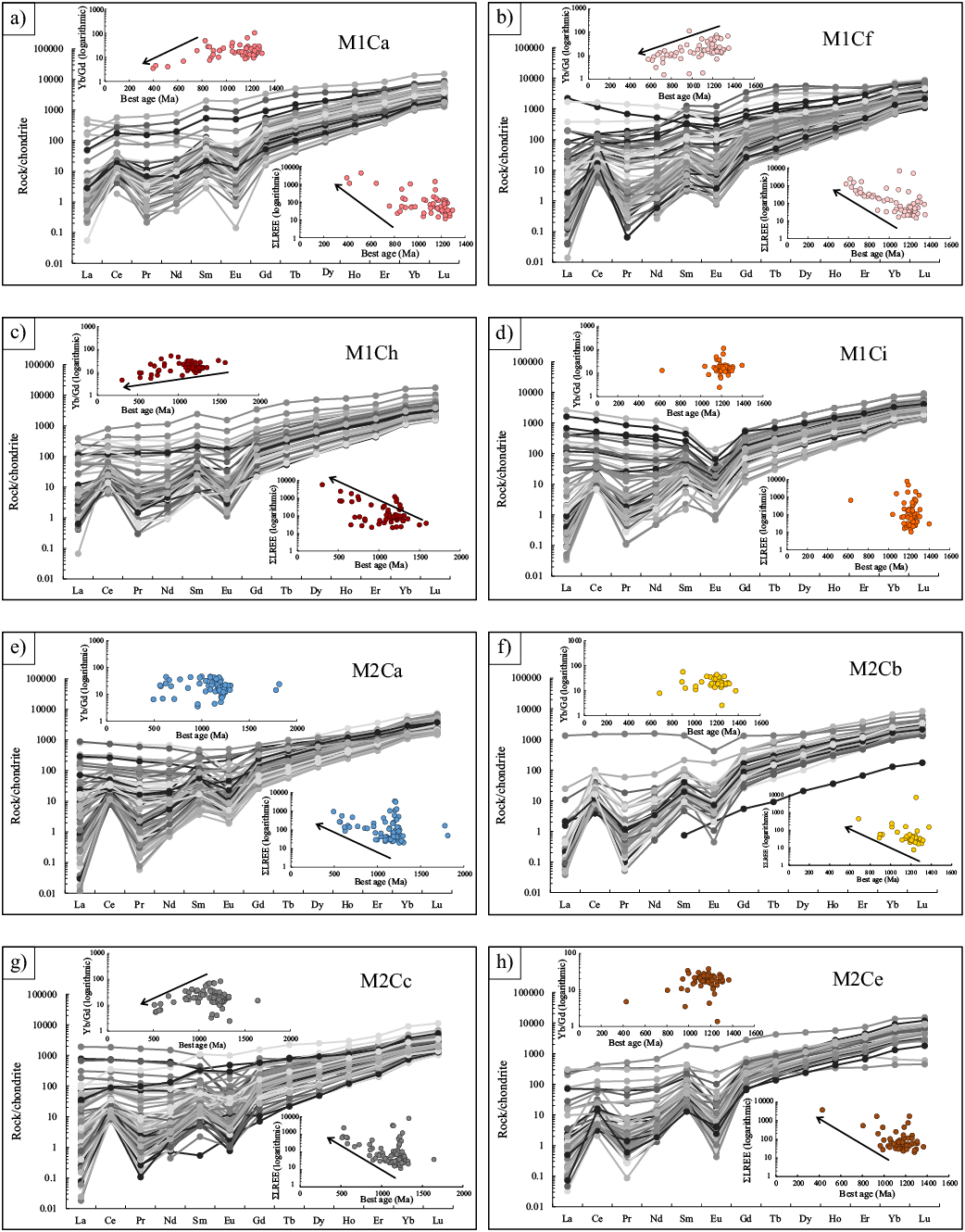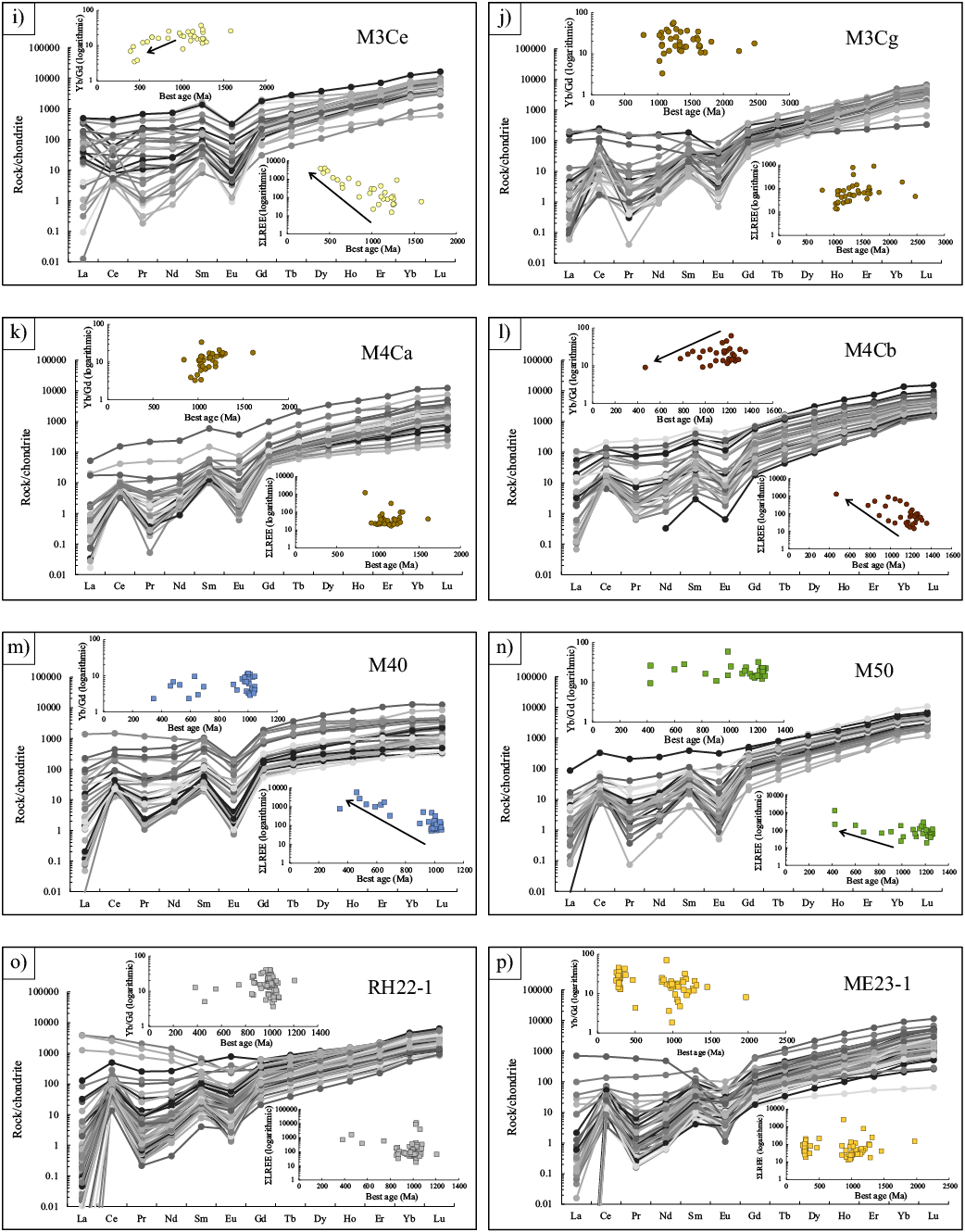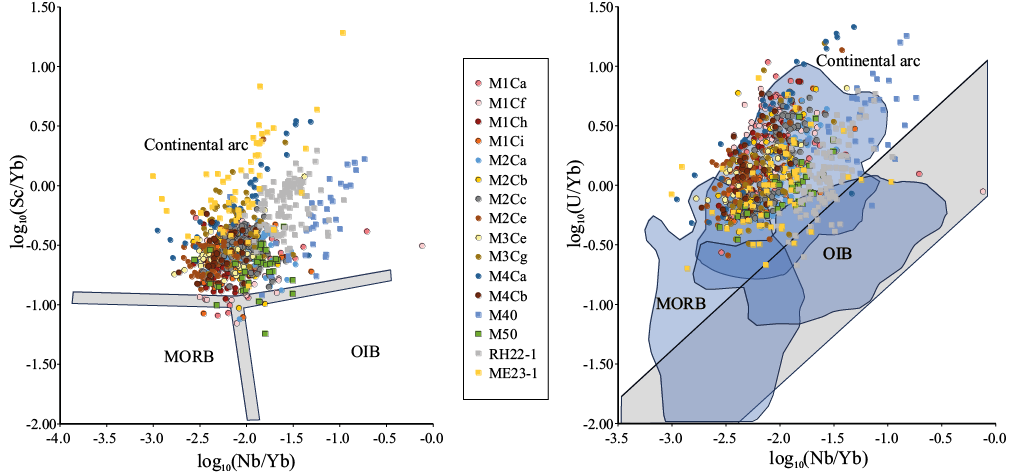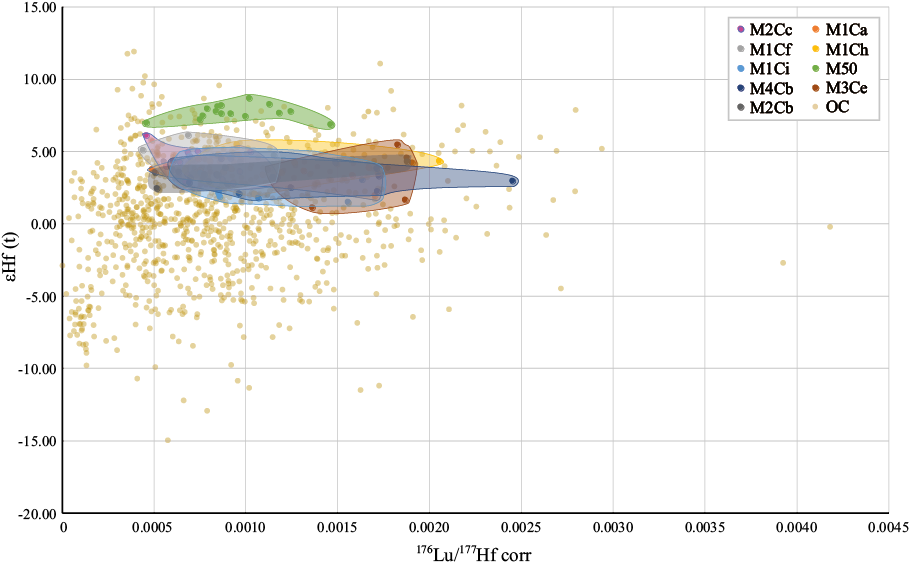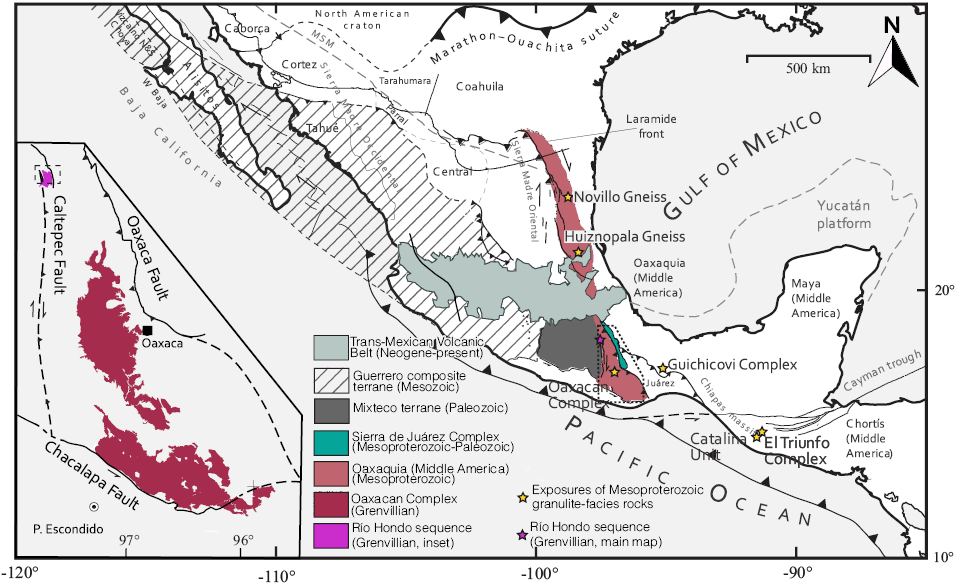
Figure 1. General map of Mexico, indicating the context of the main basement and feature outcrops. The location of the Río Hondo sequence is represented in purple color in the inset and, by a purple star, in the main Figure. Modified from Solari et al., 2014.
GEOLOGIC SETTING
The studied area is located in the Coatepec Creek, in the southern Puebla state, where the latest Permian-mid Triassic fluvial Matzitzi Formation unconformably overlies a small outcrop of high-grade gneiss interpreted as belonging to the OC (Figure 2, see also Elías-Herrera et al., 2005).The OC, the most prominent outcrop of Grenvillian granulite-facies rocks in Mexico, crops out almost continuously in southern Mexico, from the central valleys of the Tehuacán-Oaxaca region, almost to the Middle America Trench nearby Pochutla (Figure 1a). Solari et al. (2003) defined the Zapotecan orogeny as the ca. 990 Ma granulite-facies metamorphism widespread not only in the OC but also throughout Oaxaquia (ca. 730–850 °C and 7.5 ± 1 kbar; Mora and Valley, 1985; Solari et al., 2004). Before that event, several magmatic pulses were recognized: intraplate, tholeiitic anorthosite-mangerite-charnockite-granite (AMCG) magmas, dated at ca. 1020–1005 Ma in the northern OC (Keppie et al., 2003; Keppie and Dostal, 2007), but also recognized in the Novillo Gneiss (ca. 1030 Ma, Cameron et al., 2004), in the Huiznopala Gneiss (anorthositic gabbro dated at 1007 ± 3 Ma, Lawlor et al., 1999), and in the Guichicovi complex (Weber and Kohler, 1999); ca. 1280–1150 Ma alkalic, intraplate gabbro, syenite and charnockite were also recognized in the OC and Huiznopala Gneiss (Lawlor et al., 1999; Keppie et al., 2001, 2003), as well as in the Guichicovi Complex (ca. 1230 Ma, Weber and Köhler, 1999; Weber et al., 2010) and the Novillo Gneiss (ca. 1170 Ma, Cameron et al., 2004). Older magmatic pulses were also reported locally, in some of the same outcrops, with peaks at around 1.4 Ga (Weber and Schulze, 2014). Scarce granulite orthogneisses were also described as characterized by an arc-like geochemical signature, at least in the southern OC (Keppie et al., 2001) and in Huiznopala (Lawlor et al., 1999), thus reflecting the similar association of arc and backarc (intraplate) protoliths described by Weber and Hecht (2003) in the Guichicovi Complex.
A wealth of Hf isotopes has been published during the last decade on granulite-facies Oaxaquia rocks, pioneered by Weber et al. (2010) and Weber and Schulze (2014), who defined a primitive field named “typical Oaxaquia,” characterized by εHf values ranging from +5 to +7, which would correspond to a marginal or oceanic arc setting, distinguishing it from a second more evolved group (primarily based on samples from the Huiznopala Gneiss), named “continental Oaxaquia” and probably allochthonous. The less evolved crustal precursor was already connected to the active continental margin of NW Amazonia during the ca. 1.2 Ga arc magmatism. During this time, partial melting of the different crustal precursors would have occurred and the different Hf isotopic signatures ("typical Oaxaquia", "continental Oaxaquia" or the continuum between these fields) would be attributed to varying amounts of less evolved material and recycled crustal components (Weber et al., 2010; Weber and Schulze, 2014; Ibanez-Mejia et al., 2015, Solari et al., 2021). A more extensive database by Solari et al. (2021) on samples belonging to the northern OC somewhat elaborates on this concept, showing that most OC samples have εHf values constituting a continuum from moderately primitive values to more evolved ones, in which the continental Oaxaquia field constitutes an end member, whose protoliths had an estimated TDM age of ca. 1.5–1.7 Ga.
The Matzitzi Formation (Weber, 1997; Centeno-García et al., 2009; Juárez-Zúñiga et al., 2020; Bedoya et al., 2021; Martini et al., 2022) is a fluvial unit representing an anastomosing channel that was active during the latest Permian. According to the model proposed by Martini et al. (2022), the Matzitzi Formation was deposited during the early rifting of equatorial Pangea during the latest Permian. While it is mainly composed of coarse to medium-grained sandstone, the portion deposited just above the outcropping gneisses constitutes a very coarsely-grained conglomerate, with well-rounded boulders as large as 50 cm in diameter. The boulders consist of gneisses (the focus of this work), although volcanic (andesitic, dioritic, and rhyolitic) and granitic clasts of variable dimensions and, principally, of Permian age are also present (e.g., Juárez-Zúñiga et al., 2020). Some of the granitic boulders are in the age range of the nearby Cozahuico granite, ca. 270 Ma, associated with the Permian shearing along the dextral, transpressional Caltepec shear zone (e.g., Elías-Herrera and Ortega-Gutiérrez, 2002; Elías-Herrera et al., 2005).
In this work, we studied some in situ gneiss samples, which we called Río Hondo gneisses, and some of the gneissic boulders found in the Matzitzi conglomerate. With this strategy, we would characterize the high-grade gneisses, for which there are no available data, being the known, studied localities of the OC about 90 km farther to SSE (e.g., Solari et al., 2003), as well as the gneiss boulders, to determine whether they all resemble the in situ samples or if some of those found have distinct characteristics, in terms of mineralogy, age, and isotopy.
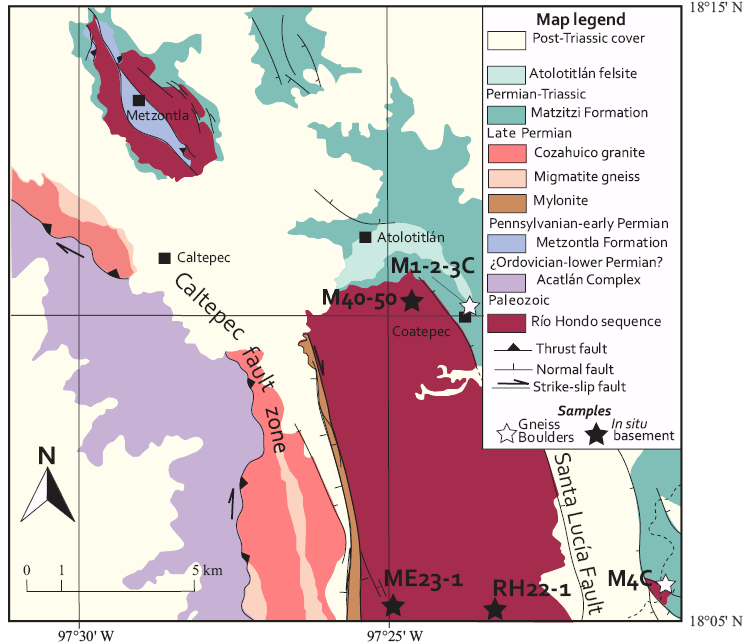
Figure 2. Geologic map of the studied area. Modified from Elías-Herrera et al. (2011), Juárez-Zúñiga et al. (2021), and Martini et al. (2022).
METHODS
After crushing, heavy minerals were concentrated from the selected samples by conventional separation techniques (e.g., Solari et al., 2007). Handpicking and mounting of zircon grains were performed under a binocular microscope, followed by epoxy pouring, curing, and polishing. Cathodoluminescence (CL) imaging was carried out using a luminoscope connected to a stereographic microscope to resolve internal structures, choose the spots to be analyzed, and eventually help the interpretation of the geochronological results. While the whole of the CL images is available in Jaramillo-Jaramillo (2020), one example of those images (one boulder and one in situ sample) is available as Figure 1 of the Supplementary Material.
U-Pb zircon geochronology was performed at the Laboratorio de Estudios Isotópicos (LEI), Centro de Geociencias, Universidad Nacional Autónoma de México, employing the methodology reported by Solari et al. (2018) by laser ablation inductively-coupled plasma mass spectrometry (LA-ICP-MS). All U-Pb analyses were obtained by coupling a Thermo ICap Qc quadrupole mass spectrometer with a Resonetics Resolution M050, 193 nm ArF excimer laser-ablation system. A 23 µm spot was employed for all U-Pb determinations, with a measured fluence of 6 J/cm2. The international standard zircon 91500 was used as the reference standard (Wiedenbeck et al., 1995), whereas the Plešovice zircon (ca. 337 Ma; Sláma et al., 2008) as the control (secondary) standard. NIST 610 synthetic glass was also used as an external standard to recalculate the elemental concentrations, employing 29Si as an internal standard in zircon. The three standards were interspersed along the whole analytical sequence, repeating their measurement twice for each of the ten unknown zircon analyses. The obtained raw data were reduced offline using Iolite v. 4.1 (Paton et al., 2011) and the VizualAge data reduction scheme of Petrus and Kamber (2012). The same software performed the quadratic error propagation of the standard zircon grains (91500) on the unknowns. During these analyses, the control standard yielded a mean 206Pb/238U age of 338.2 ± 1.6 Ma, in agreement with its accepted age. Concordia and mean age diagrams were generated using IsoplotR (Vermeesch, 2018). The obtained data were filtered for discordance, removing those analyses that yielded >30 % normal and >-5 % inverse discordance. All the analyzed isotopic and elemental concentration data are available in the Supplementary Material Table S1.
Hf isotopes were measured in situ by LA-MC-ICP-MS on some of the zircon grains previously dated by U-Pb. Hf analyses were conducted using a spot of 44 µm in diameter, right on top of the 23 µm spot used for the U-Pb analyses, employing the same zircon mount washed in ultrapure water before the run session. The methodology is the same as that of Ortega-Obregón et al. (2014). The Neptune Plus Jet interface was used to improve sensitivity in laser mode, achieving a tuning (parameters in Table 1) optimized to maximize the Hf signal, minimize oxide formation, and avoid the formation of rare-earth element (REE) oxides (cf. Payne et al., 2013), as well as control the mass bias. Once correctly tuned, the high sensitivity of the Neptune Plus allowed an average total Hf signal of more than 10 V (Table S2 of the Supplementary Material), a value that is similar to and, in many cases, exceeds other works with a similar setup (e.g., Gerdes and Zeh, 2009; Fisher et al., 2011). We avoided analyzing Hf in those zircon grains that were too small for the 44 µm spot size or those that yielded discordant U-Pb ages. Tuning was thus performed in NIST 610 standard glass, employing the same analytical conditions used during analyses (Table 1). 9–10 mL/min of N2 was added to the He carrier gas before the plasma, to increase plasma temperature and decrease oxide formation. Compared to U-Pb laser ablation analyses, downhole fractionation is not an issue for Hf analyses, but the correction for interferences of Yb and Lu is of seminal importance (e.g., Woodhead et al., 2004; Hawkesworth and Kemp, 2006; Gerdes and Zeh, 2009). To correctly apply power laws and correct for those interferences, the Yb mass bias was calculated using the measured 172Yb and 173Yb masses and the Chu et al. (2002) Yb isotope abundances, together with the 172Yb/173Yb “true” ratio of 1.35274. The 175Lu was also measured, but due to the absence of a second interference-free Lu isotope, the Yb mass bias was applied instead, assuming similar fractionation behavior between Yb and Lu. The 176Lu/175Lu ratio of 0.02656 was also used (Blichert-Toft and Albarède et al., 1997). This type of correction allows accurate and precise results to be obtained, as demonstrated by repeated analyses of several natural standard zircon grains, commonly analyzed for Hf isotopes (Table S2 Supplementary Material), and by the repeated analyses of the synthetic zircon grains of Fisher et al. (2011) doped with different amounts of REEs. These synthetic zircon grains, which contain a REE range higher than terrestrial zircon crystals, were also used to include the external reproducibility and propagate it onto the internal two standard error (2SE; i.e., twice the standard error of the mean, defined as in Paton et al., 2011; Fisher et al., 2014) measured in unknown zircon grains (e.g., Fisher et al., 2014). The raw data obtained with our analytical setup were processed off-line with a data reduction scheme written in Iolite, which corrects the detected interferences, normalizes against the reference zircon (synthetic zircon grains of Fisher et al., 2011), and propagates the external reproducibility. The 179Hf/177Hf normalizing value of 0.7325 (Patchett and Tatsumoto, 1981) was used. The 176Lu decay constant of 1.876 × 10-11 (Scherer et al., 2001) and the chondritic Hf values of Bouvier et al. (2008) were used to calculate εHf and depleted mantle (DM) model ages (TDM). The εHf and TDM, calculated employing the chondritic and depleted mantle values, respectively, were generally considered as reflecting minimum ages for the zircon’s host magma source. A second model age (TDMC) was then calculated using a value for the average continental crust of 176Lu/177Hf = 0.015 (Griffin et al., 2002) to ideally project the initial εHf of zircon grains to the depleted mantle model curve and infer possible zircon sources.
U-Pb RESULTS
We dated four in situ samples, two collected south of Coatepec and the other two along the Río Hondo Creek, about 7 km south of Coatepec (sample locations in Figure 2). Further, 12 samples were boulders extracted from the conglomerate at the unconformity between the outcropping gneisses and the Matzitzi Fm. The petrographic characteristics of the studied samples are reported, together with the U-Pb results for each sample.
